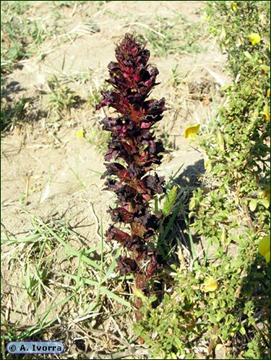CGKB News and events Management strategies
Insects - lentil
Contributors to this page: ICARDA, Aleppo, Syria (Siham Asaad, Abdulrahman Moukahal).
|
Contents: |
Scientific names
Bruchus lentis Frölich & Bruchus ervi Froel
Significance
B. ervi is a slightly elongate beetle with a body length of 3-3.8 mm. The elytra are black with light brown hairs and whitish spots. B. lentis adults are 3-3.5 mm long and have dense, grey reddish hairs on the back, marked with several whitish spots. The larvae are white-yellowish with a dark brown head.
Symptoms
The first symptom is a small dark pinhole or penetration dot on the seed at the time of harvest. If the seeds are opened the larva is found inside. Later a window appears on the seed and most of the seed is eaten out by the Bruchus larva.
Hosts
This beetle is specific to lentil.
Geographic distribution
Bruchus ervi occurring in Europe, North Africa and Southwest Asia, and Bruchus lentis in the USA, Europe, North Africa, Southwest Asia and India.
Biology and transmission
B. ervi is a slightly elongate beetle with a body length of 3-3.8 mm. The elytra are black with light brown hairs and whitish spots. B. lentis adults are 3-3.5 mm long and have dense, grey reddish hairs on the back, marked with several whitish spots. The larvae are white-yellowish with a dark brown head.
The adults move into lentil fields at the time of flowering where they feed on nectar and pollen. Ovary development and copulation occur after feeding. The females glue their elongate, yellow transparent eggs to the outside of the young pods. Upon hatching, the tiny larva penetrates the pod wall, burrows through the pod until it reaches the developing seed, enters the seed and feeds on its contents. The larva grows slowly and requires about 6 weeks until it is fully grown. Before pupation the larva eats an exit passage to the surface of the seed, leaving only a thin circular window (the epidermal membrane) intact. After pupation the emerging adult opens this membrane and leaves the seed. Adults may re-enter the seed for hibernation or hibernate in other protected places, until lentil flowering next season.
Detection/indexing method at ICARDA
- Visual inspection
Treatment/control
- At harvest, inspect seeds for small penetration holes and windows. Fumigate infested seeds before storage with phosphine (Phostoxin).
- Do not plant infested seeds.
-
If high infestations occur, apply insecticides to ensure clean seeds for export or seed production. Two applications, at early to 50% flowering and 2 weeks later, of the following insecticides provide adequate control:
- Endosulfan (Thiodan 35) at 4 ml/L
- Alpha capamethrin (Fasctac EC 10) at 0.25 ml/L
- Methyl parathion (Metyphon EC 50) at I ml/L.
Procedure followed at the centers in case positive test
- Fumigation
References and further reading
http://www.icarda.org/Publications/Field_Guides/Lentil/Lentil.htm#Lent7.Html
http://www.padil.gov.au/viewPestDiagnosticImages.aspx?id=376
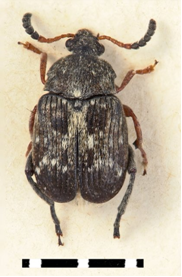
Bruchus ervi (photo: PaDIL, ICARDA) |
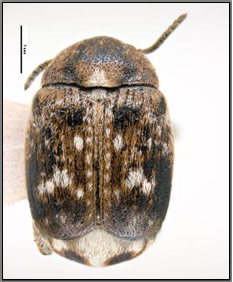
Bruchus lentis(photo: PaDIL, ICARDA) |
Cowpea seed beetle, Adzuki bean seed beetle.
Scientific names
Callosobruchus maculatus Fabricius and C. chinensis (L.)
Significance
The Callosobruchus beetles are principally a serious pest of stored products under hot dry conditions; complete destruction of grain and pulses may take place in a short time. In humid climates, the rates of increase of its competitors are so much greater that it has difficulty in establishing itself.
Symptoms
The larval stage of the weevil tunnel and develop within the beans. They may consume nearly the entire bean contents. Pupation occurs in the beans and adults emerge through a round hole in the seed coat. Damage is a combination of the feeding and contamination.
Hosts
They attack several legumes in storage, chickpea (Cicer arietinum), arhar (Cajanus cajan), green gram (Vigna radiata), pea (Pisum sativum) and kidney bean (Phaseolus vulgaris) seeds. On lentil, C. chinensis is the most common.
Geographic distribution
Both species are widespread and found in all continents with subtropical or tropical conditions.
Biology and transmission
The eggs are glued to the bean or the pod. On hatching the larvae bores into the seed where it makes a translucent 'window' in the seed before pupating. The larval and pupal stages are spent inside the bean. The adult emerges through the 'window' leaving a neat round hole. Infestations can begin in the field. Adults move to bean fields from trash beans left in sacks, harvesters, planters, or feed areas. The cowpea weevil readily attacks dried beans; thus this weevil can be a serious storage pest. Bean weevil infestations can also start in the field and may also originate from trash beans. As with the cowpea weevil, bean weevil will attack dried beans and can be a serious pest in stored beans. Broad bean weevil infestations also start in the field, but this pest is not a storage problem.
Detection/indexing method in place at the CGIAR Center at ICARDA
- Visual inspection
Treatment/control
- Cleanliness in storage: Stores should be cleaned from all residues of grains, straw and flour and be de-infested by spraying walls with malathion,
- Sacks, thresher and transportation vehicles also should be cleaned.
- Seeds stored for food/feed can be fumigated with phospine (Phostoxine) available as 0.6 g pellets and 3 g tablets. The recommended dosage is 0.5-1 tablet/m3 with an exposure time of 2-4 and 3-5 days for pellets and tablets, respectively. The major advantages of Phostoxin are that it controls all insect stages, has no residues, does not affect flavor or germination and is easy to handle.
- Seeds stored for planting can be treated with insecticides such as Actellic at 4-10 ppm a.i. (0.5 g/kg seed) or malathion at 10 ppm a.i., which will protect the seeds for several months.
- In traditional methods, small quantities of seed stored for human consumption are often mixed with different vegetable oils or other substances. Mixing seeds with olive oil and salt (5 ml and 20 g/kg seed) or Neem seed oil (3 ml/kg seed) can provide adequate control for a period of 3-4 months.
Procedure followed at the center in case of positive test
- Fumigation
References and further reading
- http://www.icarda.org/Publications/Field_Guides/Lentil/Lentil.htm#Lent7.Html
- http://www.infonet-biovision.org/default/ct/82/pests
- http://agspsrv34.agric.wa.gov.au/Ento/pestweb/Query1_1.idc?ID=-1771861620
- http://www.zin.ru/Animalia/coleoptera/rus/calmacdk.htm
- http://www.infonet-biovision.org/default/ct/82/pests
- http://agspsrv34.agric.wa.gov.au/ento/icdb/speciescompspec.idc?mnuorder=Coleoptera&mnufamily=Chrysomelidae&mnugenus=Callosobruchus.
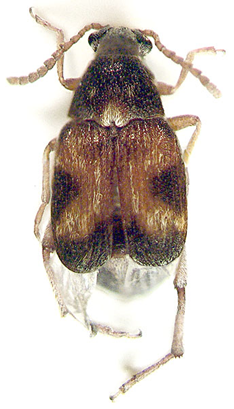
Callosobruchus maculatus (photo: www.zin.ru) |
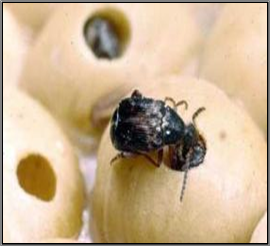
Callosobruchus maculatus (photo: |
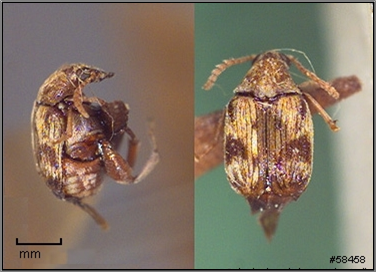
Callosobruchus chinensis (photo: agspsrv34.agric.wa.gov.au) |
Nematodes - lentil
Contributors to this page: ICARDA, Aleppo, Syria (Siham Asaad, Abdulrahman Moukahal).
Stem and bulb nematode, stem and bulb eelworm
Scientific name
Ditylenchus dipsaci(Kühn, 1857) Filipjev, 1936
Other scientific name
Tylenchus dipsaci (Kühn) Bastian
Significance
D. dipsaci is one of the most devastating plant parasitic nematodes, especially in temperate regions. Without control, it can cause complete failure of host crops.
Symptoms
D. dipsaci causes swelling and deformation of stem tissue or lesions which turn reddish-brown then black, depending on cultivar and environmental factors. Newly formed pods take on a dark-brown appearance. The lesions envelop the stem and increase in length, often advancing to the edge of an internode. Leaf and petiole necrosis is also common under heavy infestations, but can be confused with symptoms induced by fungal leaf pathogens. Infected seeds are darker, distorted, and smaller in size and may have speckle-like spots on the surface. Heavy infestations often kill the main shoots, stimulating secondary tiller formation. The more severe symptoms are usually induced by the "giant race" on legumes.
Hosts
D. dipsaci is known to attack over 450 different plant species, including many weeds. However, it occurs in more than ten biological “races” some of which have a limited host-range.
Geographic distribution
D. dipsaci occurs locally in most temperate areas of the world
Biology and transmission
In international trade D. dipsaci is liable to be carried on dry seeds and planting material of host plants. In the field the fourth-stage juvenile can withstand desiccation for many years, and although soil densities seem to decrease rapidly, the nematode can survive for years without a host plant. Nematode survival and damage are greater in heavy soils as compared to sandy soils. It can also survive on a number of weeds. Irrigation water and cultivation by contaminated farm tools and machinery are other sources of inoculum disseminate.
Detection/indexing method in place at the CGIAR Center at ICARDA
- Not significantly important
Treatment/control
- Nematode-free (certified) seeds and planting material are most essential to prevent crop damage by D. dipsaci. Hot-water treatments with different temperature-time combinations, depending on type and state of seed material, are operational and efficient to control D. dipsaci. The use of tolerant or resistant cultivars can also reduce the damage.
Procedure followed at the center in case of positive test
- Fumigation, destroying seed
References and further reading
http://www.eppo.org/QUARANTINE/nematodes/Ditylenchus_dipsaci/DITYDI_ds.pdf
http://www.doacs.state.fl.us/pi/enpp/nema/nemacirc/nem187.pdf
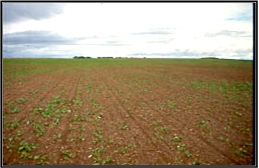 |
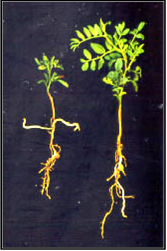 |
|
|
Stem and bulb nematode (photos: SARDI.sa.gov.au) |
||
Weeds - lentil
Contributors to this page: ICARDA, Aleppo, Syria (Siham Asaad, Abdulrahman Moukahal).
|
Contents: |
Broomrape, Branched Broomrape, Egyptian broomrape
Scientific names
Orobanche foetida Pers. and several other species: Orobanche crenata Forsk.,
Orobanche ramosa L, Orobanche aegyptiaca Pers.
Significance
Yield reductions of 30 to 70% are not uncommon. International markets may reject broomrape-contaminated produce.
Symptoms
The appearance of the parasite itself is the most diagnostic feature of infestation. The parasite has erect, branched or unbranched aerial flowering shoots. The leaves are reduced to scales and are disposed alternatively. The shoots bear bisexual tubular flowers in a spike. The tiny seeds are produced in enormous numbers in capsules.
Hosts
Broomrapes usually parasitic only broadleaved plants but there are a few records of attacks on monocots (grasses, etc.). Branched broomrape attacks many crops and common weeds. Crops attacked by branched broomrape around the world include: bean, broad bean, cabbage, capsicum (peppers), canola, carrot, cauliflower, celery, chickpea, clovers, eggplant (aubergine), flax, hemp (cannabis), hops, lentil, medics, onion, parsnip, paprika, pea, pyrethrum, sunflower, tobacco, tomato, potato.
Geographic distribution
Western and Central Asia (especially in Afghanistan, Syria, Egypt, India, Iran, Jordan, Lebanon, Morocco, Pakistan, Saudi Arabia, Australia, Europe (especially the Mediterranean), N. Africa, N. America.
Biology and transmission
Seeds germinate in moist soil at 18 to 23° C and require moist soil for one week to become established. The roots parasitic the roots of host plants for 40 to 50 days. Stems emerge in spring and are visible for only about 3 weeks from the end of September through to October. Flowering is rapid, within 6 to 9 days after stem emergence, with a similar period between the cessation of flowering and the ripening of fruit. An infestation may contain many plants that do not produce above-ground parts.
Dispersal from property to property and within properties in the infested area in South Australia appears to be mainly by carriage on vehicles and machinery. Seeds stick to equipment and animals that contact the plant and can also be dispersed by wind and water (including irrigation water/sprinklers), in animal manure, soil, fodder, on livestock and on footwear and clothing. Seeds attach to crop seeds and other produce. Seedlings imported from infested areas can carry seeds stuck to their leaves or in the soil. Seeds remain viable after passage through the digestive tracts of animals including cattle and goats.
Detection/indexing method at ICARDA
- Filter washing test
Treatment/control
-
Hand weed shoots prior to their seed formation to reduce inoculum levels. This is recommended in minor infestations only.
- Sow the crop late to help plants escape the worst effects of infection.
- Plow deep to bury Orobanche seeds into deeper soil layers to reduce infestation.
- Use selective herbicides such as imazaquin (10-15 ml a.i. /ha).
- Use soil solarization to reduce soil-borne inoculum.
- Use resistant varieties, if available.
Procedure followed at the centers in case of positive test
- Early field inspection and roguing, mechanical cleaning
References and further reading
http://www.icarda.org/Publications/Field_Guides/Lentil/Lentil.htm#Lent7.Html
|
Orobanche foetida (photo: ICARDA) |
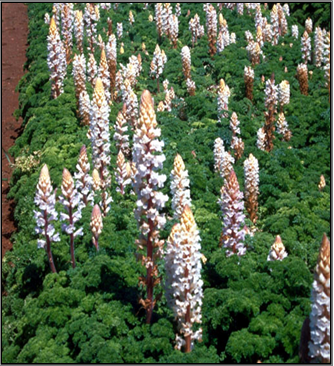
Orobanche crenata (photo: ICARDA) |

Orobanche ramosa (photo: ICARDA) |
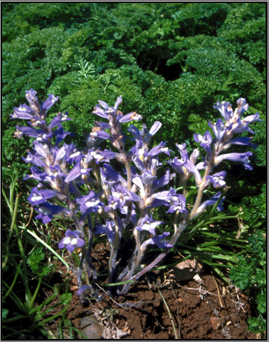
Orobanche egyptiaca (photo: ICARDA) |
Scientific names
Cuscuta campestris Yuncker and Cuscuta hyalina Roth.
Other scientific names
C. pentagona
Significance
The effect of field dodder on 12 legume crops was investigated in a greenhouse experiment. The legume crops showed great variations in response to field dodder parasitism. Based on the reduction in host dry weight (biological yield) caused by the parasite, lentil lost >50% of its biological yield was considered highly susceptible.
Symptoms
The appearance of the parasite itself is the best diagnostic symptom. It has fine, yellow or orange, thread-like branches which grow and entwine around the stems and other aboveground parts of the host.
Dodder-infected areas appear as patches in the field and continue to enlarge during the growing season. In late spring and early summer, dodder produces a massed cluster of white flowers.
Infected host plants become weakened, decline in vigor and produce poor yields.
Several patches might coalesce to form large areas that can be easily recognized by the yellowish color of the parasite strands.
Hosts
It is the most important Cuscuta species, attacking a wide (C. campestris) range of species, including vegetables, fruits, ornamentals and woody plants. It is reported as a weed in 25 crops in 55 countries.
Geographic distribution
Europe to North Africa and eastern Asia
Detection/indexing method in place at the CGIAR Center at ICARDA
- Filter washing Test
Treatment/control
- Dodder is best controlled through establishment prevention by using clean seed. Ornamental beds should be kept clean of seed-producing plants. Once dodder becomes established, eradication is almost impossible. Mechanical removal can be attempted, but once dodder has produced the haustoria it is near impossible to avoid damage to the host plant. If dodder has germinated and has attached to a host plant, removal of both is recommended to eradicate.
- Use of pre-emergent herbicides is the best chemical approach. These products must be applied prior to the germination of the seed as the small seedling root will drop off once the haustoria has formed. Dinitroanaline herbicides have been reported to be effective. Dichlobenil has also shown good results. Read all labels to ensure that the herbicides can be used around the host plants. Glyphosate has shown results as a postemergent herbicide, but its use is limited as it will also damage the host plant. Phenoxy herbicides have only shown limited control and again injury to the host plant can occur.
Procedure followed at the centers in case of positive test
- Early field inspection and roguing, mechanical cleaning
References and further reading
http://www.icarda.org/Publications/Field_Guides/Lentil/Lentil.htm#Lent7.Html
http://www.weedalert.com/weed_pages/wa_dodder.htm
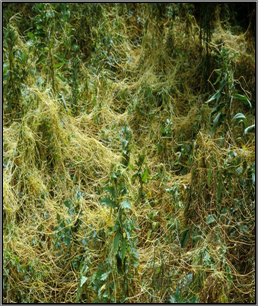
Cuscuta hyalina (photo: ICARDA) |
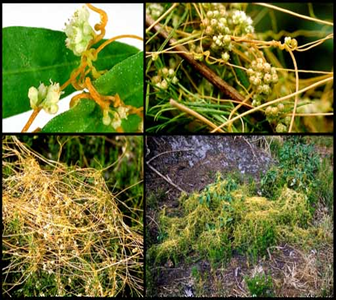
Cuscuta campestris (photo: ICARDA) |
Import/export of cowpea germplasm
Contributors to this section: IITA, Nigeria (M. Ayodele, L. Kumar).
Cowpea is a crop under the mandate of IITA. It is very important to remember that an International Phytosanitary Certificate is always required for any plant germplasm exchange.
The requirements of countries that request and receive seed from IITA Headquarters located in Nigeria have been collected from the permits granted to IITA for exportation of cowpea experimental seed. It indicates specific requirements and the pathogens and pest that seed should be free of when it is imported to a given country.
Please consider that:
- The information received from the same country may vary from a permit to another; therefore the latest has been considered the valid one.
- It is always advisable before sending a shipment to contact the consignee in the recipient country to confirm the information reported in this table.
More Articles...
Subcategories
-
main
- Article Count:
- 11
-
Stog
- Article Count:
- 2
-
Stog-rice
- Article Count:
- 7
-
Stog-sorghum
- Article Count:
- 11
-
Stog-common-bean
- Article Count:
- 10
-
stog-forage-legume
- Article Count:
- 10
-
stog-forage-grass
- Article Count:
- 11
-
stog-maize
- Article Count:
- 9
-
stog-chickpea
- Article Count:
- 10
-
stog-millets
- Article Count:
- 12
-
stog-barley
- Article Count:
- 10
-
stog-groundnut
- Article Count:
- 9
-
stog-pigeon-pea
- Article Count:
- 8
-
stog-wheat
- Article Count:
- 10
-
stog-lentil
- Article Count:
- 9
-
stog-cowpea
- Article Count:
- 10
-
stog-faba-bean
- Article Count:
- 9
-
risk management
- Article Count:
- 4
-
decision support tool
- Article Count:
- 3
-
stog-clonal
- Article Count:
- 23
-
developing strategies
- Article Count:
- 4





